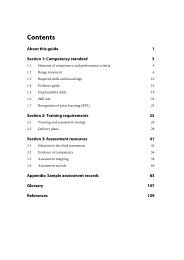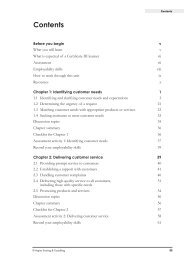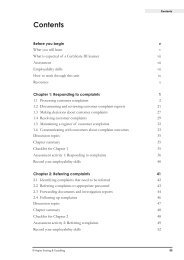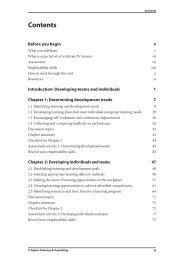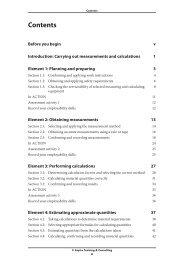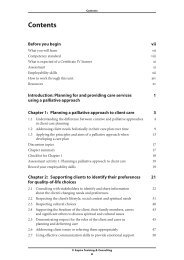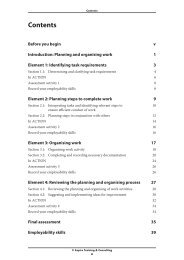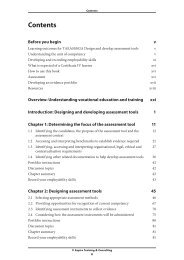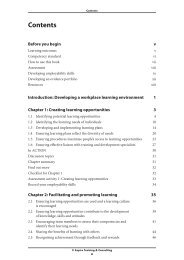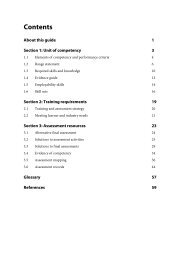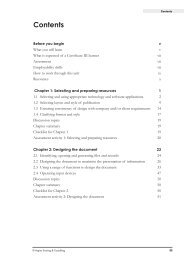CHCDIS405A Facilitate skills development and maintenance
CHCDIS405A Facilitate skills development and maintenance
CHCDIS405A Facilitate skills development and maintenance
You also want an ePaper? Increase the reach of your titles
YUMPU automatically turns print PDFs into web optimized ePapers that Google loves.
Contents<br />
Contents<br />
Before you begin<br />
What you will learn<br />
Competency st<strong>and</strong>ard<br />
What is expected of a Certificate IV learner<br />
Assessment<br />
Employability <strong>skills</strong><br />
How to work through this unit<br />
Resources<br />
vii<br />
vii<br />
ix<br />
xi<br />
xi<br />
xi<br />
xiii<br />
xiv<br />
Introduction: Facilitating <strong>skills</strong> <strong>development</strong> <strong>and</strong> <strong>maintenance</strong> 1<br />
Chapter 1: Assessing the learning ability <strong>and</strong> needs of 3<br />
the person<br />
1.1 Assessing the person’s <strong>skills</strong> <strong>development</strong>/<strong>maintenance</strong> needs 4<br />
1.2 Identifying <strong>skills</strong> <strong>development</strong> or <strong>maintenance</strong> opportunities 12<br />
1.3 Documenting assessment outcomes according to organisation guidelines 15<br />
1.4 Making referrals to other staff or specialist services 18<br />
Discussion topics 20<br />
Chapter summary 20<br />
Checklist for Chapter 1 20<br />
Assessment activity 1: Assessing the learning ability <strong>and</strong> needs of the person 21<br />
Record your employability <strong>skills</strong> 22<br />
Chapter 2: Developing a person-centred <strong>skills</strong> <strong>development</strong> 23<br />
<strong>and</strong> <strong>maintenance</strong> plan<br />
2.1 Engaging the person with a disability in identifying their learning goals 24<br />
2.2 Identifying learning strategies to address the person’s goals 28<br />
2.3 Developing a formal person-centred <strong>skills</strong> <strong>development</strong>/<strong>maintenance</strong> plan 31<br />
2.4 Documenting the person-centred <strong>skills</strong> <strong>development</strong>/<strong>maintenance</strong> plan 36<br />
Discussion topics 38<br />
Chapter summary 38<br />
Checklist for Chapter 2 38<br />
Assessment activity 2: Developing a person-centred <strong>skills</strong> <strong>development</strong> 39<br />
<strong>and</strong> <strong>maintenance</strong> plan<br />
Record your employability <strong>skills</strong> 40<br />
© Aspire Training & Consulting<br />
iii
<strong>CHCDIS405A</strong> <strong>Facilitate</strong> <strong>skills</strong> <strong>development</strong> <strong>and</strong> <strong>maintenance</strong><br />
Chapter 3: Implementing the <strong>skills</strong> <strong>development</strong>/<strong>maintenance</strong> 41<br />
plan<br />
3.1 Implementing <strong>skills</strong> learning <strong>and</strong> <strong>maintenance</strong> strategies in a motivating, 42<br />
empowering <strong>and</strong> respectful manner<br />
3.2 Ensuring the <strong>skills</strong> <strong>development</strong>/<strong>maintenance</strong> plan is implemented 45<br />
consistently<br />
3.3 Accessing <strong>and</strong> using equipment <strong>and</strong> resources to facilitate learning 48<br />
3.4 Maintaining records to demonstrate the person’s achievements <strong>and</strong> to 51<br />
assist with monitoring <strong>and</strong> review of the plan<br />
Discussion topics 53<br />
Chapter summary 53<br />
Checklist for Chapter 3 54<br />
Assessment activity 3: Implementing the <strong>skills</strong> <strong>development</strong>/<strong>maintenance</strong> plan 55<br />
Record your employability <strong>skills</strong> 56<br />
Chapter 4: Evaluating <strong>skills</strong> <strong>development</strong> <strong>and</strong> reviewing 57<br />
the plan<br />
4.1 Providing feedback about the person’s progress towards learning objectives 58<br />
4.2 Reviewing records, evaluating <strong>and</strong> changing the <strong>skills</strong> 62<br />
<strong>development</strong>/<strong>maintenance</strong> plan<br />
4.3 Identifying opportunities to maintain <strong>and</strong> enhance <strong>skills</strong> in an ongoing way 65<br />
Discussion topics 67<br />
Chapter summary 67<br />
Checklist for Chapter 4 68<br />
Assessment activity 4: Evaluating <strong>skills</strong> <strong>development</strong> <strong>and</strong> reviewing the plan 69<br />
Record your employability <strong>skills</strong> 69<br />
Chapter 5: Using incidental learning to enhance <strong>skills</strong> 71<br />
<strong>development</strong><br />
5.1 Identifying informal learning opportunities <strong>and</strong> encouraging learning 72<br />
5.2 Withdrawing support to encourage experiential learning 77<br />
5.3 Providing prompt <strong>and</strong> constructive advice <strong>and</strong> feedback 80<br />
5.4 Providing encouragement when the person takes initiative 83<br />
5.5 Identifying <strong>and</strong> describing informal learning opportunities in 87<br />
the context of policies <strong>and</strong> procedures<br />
Discussion topics 88<br />
Chapter summary 89<br />
Checklist for Chapter 5 89<br />
Assessment activity 5: Using incidental learning to enhance <strong>skills</strong> <strong>development</strong> 90<br />
Record your employability <strong>skills</strong> 91<br />
© Aspire Training & Consulting<br />
iv
Contents<br />
Final assessment: <strong>CHCDIS405A</strong> <strong>Facilitate</strong> <strong>skills</strong> <strong>development</strong> 93<br />
<strong>and</strong> <strong>maintenance</strong><br />
Employability <strong>skills</strong> 98<br />
Glossary 99<br />
© Aspire Training & Consulting<br />
v
Chapter 3: Implementing the <strong>skills</strong> <strong>development</strong>/<strong>maintenance</strong> plan<br />
3.4 Maintaining records to demonstrate the<br />
person’s achievements <strong>and</strong> to assist with<br />
monitoring <strong>and</strong> review of the plan<br />
Maintaining records to demonstrate the person’s achievements has a dual purpose;<br />
records monitor a client’s progress as well as being a tool to share information with<br />
other members of the support team.<br />
Maintaining the <strong>skills</strong> <strong>development</strong> plan<br />
Once you have drawn up your client’s <strong>skills</strong> <strong>development</strong> plan, maintaining records<br />
<strong>and</strong> monitoring progress primarily involves recording any ‘evidence of achievement’ of<br />
expected learning outcomes.<br />
As a supervisor or support worker you must record what you have observed the client<br />
perform in order to monitor <strong>and</strong> review their <strong>development</strong>.<br />
When making <strong>and</strong> recording observations:<br />
• record only what you have observed yourself; for example, ‘Shirley was able to wash<br />
her upper body unassisted this morning as part of her shower routine’<br />
• if you are reporting what someone has told you, quote their exact words <strong>and</strong> attribute<br />
them to the speaker<br />
• state the number of times the activity was performed <strong>and</strong> under what conditions<br />
• sign <strong>and</strong> date all entries<br />
• consider a reward system like stars to show achievement.<br />
Care plan<br />
As a supervisor you record any changes that need to be made to the client’s care plan<br />
as a result of either an increase or a decline in their skill level. These changes should be<br />
discussed with the client <strong>and</strong> an amended care plan documented <strong>and</strong> signed by yourself<br />
<strong>and</strong> the client. You then need to make sure all support workers are informed of the<br />
changes.<br />
Rosters<br />
Once you have amended the care plan, a supervisor needs to adjust rosters to cater<br />
for this amendment. Most organisations have a computer-based rostering system you<br />
update with any changes to the duties to be performed or changes to the support workers<br />
providing the service.<br />
© Aspire Training & Consulting<br />
51
<strong>CHCDIS405A</strong> <strong>Facilitate</strong> <strong>skills</strong> <strong>development</strong> <strong>and</strong> <strong>maintenance</strong><br />
Work instructions<br />
When new procedures are added to a client’s program, you may need to write a detailed<br />
work instruction to ensure consistency in the way the procedure is performed. You<br />
may also require the assistance of other health professionals; for instance, if you<br />
are introducing a program of stretching exercises you may need the assistance of a<br />
physiotherapist to write the work instruction. Check your workplace guidelines, as any<br />
work instructions form part of the quality system.<br />
Guidelines<br />
Where the change in a client’s skill level requires a change to guidelines, you need to<br />
follow workplace procedures as this also involves a change to the quality system. An<br />
example would be if you change guidelines for support workers assisting clients to<br />
access an ATM.<br />
Communication books<br />
A communication book is used to communicate information between support workers,<br />
the family, the client <strong>and</strong> other relevant health professionals. It remains in the client’s<br />
home <strong>and</strong> is an open document for all to see. Entries must be fact, not opinion; report<br />
only what you have observed. All entries should be signed <strong>and</strong> dated.<br />
File notes<br />
When you have had a face-to-face discussion with your client regarding their <strong>skills</strong><br />
<strong>development</strong> progress, record the conversation in a file note. Follow workplace<br />
procedures, as file notes are a legal record of dialogue.<br />
Staff meetings<br />
A client’s <strong>skills</strong> <strong>development</strong> requirements may be discussed at a staff meeting. In order<br />
to disseminate information, it should be shown on the agenda <strong>and</strong> minuted.<br />
Training or information sessions<br />
Where training or an information session is run for staff who will be working with a<br />
client in their skill <strong>development</strong>, this information should be recorded as a client file note<br />
<strong>and</strong> in the support worker’s training record.<br />
Case management meetings<br />
A formal agenda <strong>and</strong> minutes should be recorded for case management meetings. This<br />
is usually undertaken by the case manager.<br />
The following example describes poor <strong>and</strong> good reporting of a situation.<br />
© Aspire Training & Consulting<br />
52
Chapter 3: Implementing the <strong>skills</strong> <strong>development</strong>/<strong>maintenance</strong> plan<br />
Example<br />
You are providing assistance to Jimmy to learn to dress himself in the morning. Jimmy is 19<br />
years old <strong>and</strong> has cerebral palsy. It is one of Jimmy’s performance criteria that he be able to<br />
live independently.<br />
This morning when you are dressing him, you suggest that he tries to do up the buttons on his<br />
shirt for himself. Jimmy tries to do this, but is unsuccessful because of his lack of fine motor <strong>skills</strong>.<br />
Three times he tries to get the buttons through the holes. He then shouts at himself for not being<br />
able to do it. You intervene <strong>and</strong> assist him to button his shirt.<br />
The following example shows good <strong>and</strong> poor recording in a communication book.<br />
Poor reporting:<br />
Jimmy got frustrated getting dressed this morning.<br />
Good reporting:<br />
Jimmy attempted to do up the buttons on his shirt three times this morning <strong>and</strong> then needed<br />
assistance from me to achieve this. (signed <strong>and</strong> dated)<br />
Practice task 12<br />
In Chapter 1 you talked to an experienced person about the records they keep. Review your<br />
findings from that discussion, making a list of what documents you would need to complete to<br />
monitor <strong>skills</strong> <strong>development</strong>.<br />
Discussion topics<br />
Learners in a classroom can form a discussion group or have a debate. Those in the<br />
workplace might like to brainstorm these ideas with their colleagues. If you are learning<br />
independently, you might like to set up a chat room with other learners or ask a friend<br />
for their opinion.<br />
• Keeping people motivated is the key to achieving the learning outcomes of the <strong>skills</strong><br />
<strong>development</strong> plan.<br />
• Witnessing someone develop new <strong>skills</strong>, <strong>and</strong> the satisfaction that comes from it,<br />
can be the most inspiring aspect of working with people with disabilities. Give<br />
examples.<br />
• ‘Balancing a client’s right to dignity of risk with our duty of care can be difficult.<br />
Some times I just want to jump in <strong>and</strong> help.’ Discuss this statement.<br />
Chapter summary<br />
•<br />
•<br />
•<br />
Your client learns best when you provide a supportive learning environment that<br />
encourages this <strong>development</strong>.<br />
In order to promote your client’s <strong>development</strong> information must be shared with all<br />
relevant people <strong>and</strong> consistency assured in implementing the <strong>skills</strong> <strong>development</strong><br />
plan.<br />
There are aids <strong>and</strong> specialised equipment you can access to make learning easier for<br />
your client.<br />
© Aspire Training & Consulting<br />
53
<strong>CHCDIS405A</strong> <strong>Facilitate</strong> <strong>skills</strong> <strong>development</strong> <strong>and</strong> <strong>maintenance</strong><br />
•<br />
•<br />
In some cases, clients may require extra resources to support them carry out<br />
functions such as turning pages, taking notes or to help with health needs during<br />
formal training sessions.<br />
You must monitor <strong>and</strong> record client progress accurately against their <strong>development</strong><br />
plan <strong>and</strong> all other relevant documentation.<br />
Checklist for Chapter 3<br />
Tick the box when you can do the following.<br />
Implement <strong>skills</strong> learning <strong>and</strong> <strong>maintenance</strong> strategies in a motivating, empowering<br />
<strong>and</strong> respectful manner<br />
Ensure the <strong>skills</strong> <strong>development</strong>/<strong>maintenance</strong> plan is implemented consistently<br />
Access <strong>and</strong> use equipment <strong>and</strong> resources to facilitate learning<br />
Maintain records to demonstrate the person’s achievements <strong>and</strong> to assist with<br />
monitoring <strong>and</strong> review of the plan<br />
© Aspire Training & Consulting<br />
54
Chapter 3: Implementing the <strong>skills</strong> <strong>development</strong>/<strong>maintenance</strong> plan<br />
Assessment activity 3<br />
Implementing the <strong>skills</strong> <strong>development</strong>/<br />
<strong>maintenance</strong> plan<br />
The following table maps the assessment activity for this chapter against the element<br />
<strong>and</strong> performance criteria of Element 3 in <strong>CHCDIS405A</strong> <strong>Facilitate</strong> <strong>skills</strong> <strong>development</strong> <strong>and</strong><br />
<strong>maintenance</strong>. The activity has been designed for all learners to complete.<br />
Part Element Performance criteria<br />
Whole activity 3 All<br />
Read the case study, then answer the questions that follow.<br />
Case study<br />
Kathleen is a supervisor with an organisation that provides services to older people <strong>and</strong> people<br />
with disabilities. Kathleen is asked if she can meet with a new client, Duane, who has had a stroke<br />
<strong>and</strong> is about to return home. Kathleen is to assess what services Duane needs to be put in place<br />
to assist with his rehabilitation.<br />
Kathleen visits Duane <strong>and</strong> talks to him about his needs. Duane’s goal is to regain full mobility so<br />
he can continue to live on his own. As a result of the stroke, Duane’s balance is impaired <strong>and</strong> he<br />
is very slow <strong>and</strong> unsure in his movements.<br />
Kathleen talks to Duane for about an hour <strong>and</strong> discusses a support program with him. They<br />
decide he needs home care twice a week <strong>and</strong> personal care every morning until he gains<br />
enough confidence to be able to shower himself. Duane tells Kathleen that he wants to continue<br />
his weekly session with a physiotherapist as part of his rehabilitation. She encourages him to<br />
do this, suggesting she arrange transport as part of his program. Kathleen also suggests she<br />
organise a walking frame for Duane to use around the house to help with his balance.<br />
Upon returning to the office Kathleen draws up a service delivery plan <strong>and</strong> enters Duane’s details<br />
on the database. She phones two support workers, Jenny <strong>and</strong> Pallini, to organise home care<br />
<strong>and</strong> personal care, briefing both on Duane’s goal of becoming independent <strong>and</strong> the details of<br />
his program. These details are also recorded on Duane’s care plan for the support workers to<br />
see. Kathleen also organises the hire of a walking frame, ensuring it is there when Duane arrives<br />
home from hospital.<br />
Jenny calls on Duane twice a week to provide home care. She gets on well with Duane <strong>and</strong> he<br />
often chats to her about how he used to go swimming in the bay each morning. Jenny suggests<br />
that Duane may like to try swimming again as part of his rehabilitation. After completing her<br />
shift, Jenny makes a note of this conversation in the communication book <strong>and</strong> gives Kathleen a<br />
call to tell her.<br />
Pallini assists Duane to shower each morning. Duane undresses in the bedroom <strong>and</strong> then uses<br />
his walking frame to go to the bathroom where Pallini assists him to sit on a shower chair. She<br />
turns the water on for him <strong>and</strong> he can then wash himself.<br />
In the second week Duane decides he will try walking to the bathroom without the walking<br />
frame. Pallini assists <strong>and</strong> he manages to walk to the shower chair on his own. Pallini records this<br />
in the communication book so Jenny will know. She also phones Kathleen to tell her of Duane’s<br />
progress, which Kathleen notes on Duane’s <strong>development</strong> plan.<br />
continued …<br />
© Aspire Training & Consulting<br />
55
Final assessment: <strong>CHCDIS405A</strong> <strong>Facilitate</strong> <strong>skills</strong> <strong>development</strong> <strong>and</strong> <strong>maintenance</strong><br />
Final assessment<br />
<strong>CHCDIS405A</strong> <strong>Facilitate</strong> <strong>skills</strong><br />
<strong>development</strong> <strong>and</strong> <strong>maintenance</strong><br />
To be assessed as competent in <strong>CHCDIS405A</strong> <strong>Facilitate</strong> <strong>skills</strong> <strong>development</strong> <strong>and</strong><br />
<strong>maintenance</strong>, you must provide evidence of the specified essential knowledge <strong>and</strong> <strong>skills</strong>.<br />
Details of the essential knowledge <strong>and</strong> <strong>skills</strong> can be found in the ‘Before you begin’<br />
section of this workbook.<br />
Assessment mapping<br />
The following table maps this final assessment activity against the elements <strong>and</strong><br />
performance criteria of <strong>CHCDIS405A</strong> <strong>Facilitate</strong> <strong>skills</strong> <strong>development</strong> <strong>and</strong> <strong>maintenance</strong>.<br />
Part Element Performance criteria<br />
A All All<br />
B All All<br />
C All All<br />
Detailed mapping of this workbook against the methods of assessment, the elements,<br />
the performance criteria <strong>and</strong> essential <strong>skills</strong> <strong>and</strong> knowledge is available in the Aspire<br />
Trainer’s <strong>and</strong> assessor’s guide for this unit.<br />
The following activity forms part of your assessment of competence. You may also need<br />
to provide various workplace documents or third-party reports. Your trainer will give<br />
you guidance in this area.<br />
The following activity has been designed for all learners to complete.<br />
Part A:<br />
Essential <strong>skills</strong><br />
Your trainer needs to observe you demonstrating the following essential <strong>skills</strong> in your<br />
workplace or in a simulated environment.<br />
Essential <strong>skills</strong><br />
Demonstrate how you:<br />
• underst<strong>and</strong> <strong>and</strong> adhere to own work role<br />
<strong>and</strong> responsibilities.<br />
Demonstrate how you:<br />
• follow organisation policies <strong>and</strong> protocols.<br />
Demonstrate how you:<br />
• liaise <strong>and</strong> report to relevant personnel.<br />
Example<br />
Tell your trainer/assessor what you would say<br />
if the client asked you to do something that<br />
wasn’t in your job description.<br />
Show your trainer/assessor a copy of an<br />
incident report you have written.<br />
Show your trainer/assessor an entry you<br />
have written in the communication book.<br />
continued …<br />
© Aspire Training & Consulting<br />
93
Glossary<br />
Glossary<br />
Acquired disability: An acquired disability is where impairment arises after birth as a<br />
result of a disease or trauma.<br />
Active support: Active support is assisting people in a way that ensures individuals are<br />
involved in learning <strong>skills</strong> that can contribute to their own support: doings things with<br />
people rather than for them.<br />
Advocate: An advocate helps their client make decisions about their care. An advocate<br />
may attend discussions about their client’s support <strong>and</strong> care. They make sure their client<br />
receives the service they want <strong>and</strong> need.<br />
Auslan: Auslan st<strong>and</strong>s for Australian sign language. It is a language of signs, body<br />
movements <strong>and</strong> facial expressions used by deaf people or by an interpreter between a<br />
hearing <strong>and</strong> deaf person. It is only used in Australia.<br />
Cognitive: Cognitive function refers to how people think, learn <strong>and</strong> judge.<br />
Communication board: A communication board allows an individual to communicate<br />
their needs or feelings in a nonverbal way. It includes frequently used letters, words or<br />
pictures that the person can point or gesture to.<br />
Confidentiality: Confidentiality is an obligation that restricts an individual or<br />
organisation from using or disclosing information about a person that is outside of the<br />
scope for which the information was collected.<br />
Dignity of risk: Dignity of risk means that a person has the right to make their own<br />
choices <strong>and</strong> to take risks. It is the role of the community worker to ensure the individual<br />
underst<strong>and</strong>s the risks they are taking <strong>and</strong> therefore is making an informed choice.<br />
Duty of care: Duty of care is the term used to describe the obligations employers <strong>and</strong><br />
employees have to each other <strong>and</strong> those they are caring for. It includes making sure<br />
you provide appropriate care to meet the person’s needs, treat them with respect <strong>and</strong><br />
maintain a person’s right to privacy.<br />
Fine motor <strong>skills</strong>: Fine motor <strong>skills</strong> involve precise controlled movement of the h<strong>and</strong>s<br />
<strong>and</strong> fingers. Typically the <strong>skills</strong> are grasping, manipulating <strong>and</strong> h<strong>and</strong>–eye coordination.<br />
Examples are writing, pushing small buttons, using scissors or playing the piano.<br />
Gross motor <strong>skills</strong>: Gross motor <strong>skills</strong> are movements involving the arm, leg, or feet<br />
muscles or the entire body. Things like crawling, walking, running <strong>and</strong> jumping are<br />
gross motor <strong>skills</strong>.<br />
Incidental learning: Incidental learning is not planned or intentional. It occurs when<br />
people learn <strong>skills</strong> from everyday life activities such as conversations, observing things,<br />
trial <strong>and</strong> error. For example, social <strong>skills</strong> are often learnt through day-to-day activity.<br />
Person-centred approach: A person-centred approach to service delivery ensures that<br />
the person accessing a service is central to service delivery; responds to the whole person<br />
<strong>and</strong> focuses on a social model of care rather than a medical model of care.<br />
© Aspire Training & Consulting<br />
99



